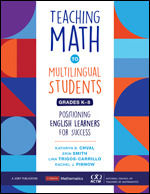
Desiree Harrison 0:00
Chances are that if you are currently teaching or have taught in the past five years, you have students who are not yet fluent in English. So, how do you position multilingual students?
If you’re having trouble answering this question, you are not alone.
The Math education world talks a lot about positioning students for success, but What exactly is positioning? Turns out that the definition of positioning in the education world is not just about the physical location of one student versus another.
The type of positioning involved with ensuring students know they are competent and capable involves the labels a teacher assigns to students and the asset-based or deficit-based lens that an adult places upon a child.
It involves the roles, rights, responsibilities of children - so answering questions such as -
Do students see themselves as leaders or as someone who always needs help from others? Are students I serve allowed to share their thoughts and opinions in class or are they rarely called upon to share their thinking with others?
What kinds of assumptions am I making about students?
Why am I making these assumptions?
Today’s episode explores these ideas and how our actions as parents and educators influence how children see themselves through an explanation of something known as “positioning theory”. While this theory influences many demographics, our guest, Dr. Kathyrn Chval, who is The Dean of the College of Education for the University of Illinois-Chicago, and author of 18 books and over 50 research publications, has spent decades researching the intersection of positioning theory with multilingual learners as they are engaging with mathematics. If you’re a teacher, get your entire grade level team together to listen to this episode and talk through the strategies mentioned. If you’re a parent, make sure your child’s teacher and principal are aware of this episode in particular, because all students deserve to be positioned for success.
Desiree Harrison 2:57
Today on the Kids Math Talk Podcast, we have the lead author of the new book, Teaching Math to Multilingual Students, grades K-8. Please welcome, Kathryn Chval.
Kathryn Chval 2:58
Thank you, Desiree. I appreciate it. Wonderful to be here. And to listen to you and talk with you. And hopefully others will listen as well.
Desiree Harrison 3:06
So, that is the goal at Kids Math Talk. We're here to keep the conversation active and positive and also to make connections to things that are happening in the math education world more accessible to educators and to parents who might not be in different organization and who might not be reading all the same materials because we're stronger together.
Part of the title, actually, that I hadn't said yet, is positioning English Language Learners for success.
And that word positioning, we hear a lot, and we're hearing it a lot more as districts and schools are thinking and talking more about equitable access. And this word positioning, just is becoming a buzzword, but it's not necessarily being defined, and so we're getting different interpretations of what it means. And I've even had some teachers engage in conversations with me about that word, thinking that it's physical positioning of students around the room, which is one definition of the word, but that's not necessarily what is meant by your text.
So, to start us off, tell us about what positioning students means and why this is so important.

Kathryn Chval 4:22
Ah, you know, I've done a lot of professional development with teachers across the country, and in recent years I've done 60 hours around teaching multilingual learners with groups of teachers.
So, they're like, I've had professional development on using visuals, or other types of strategies and out of all of the topics, the one topic they're like, "I've never had this before", is positioning.
So, when we did the first session was 3 hours, and then they asked for 3 more hours. So, there's great interest in positioning.
I think some people assume it's the physical positioning in a classroom.
So, I'll tell a story from my experiences as a child in math. Some practices that used to be used in math classes we don't use anymore, but in this particular classroom, the kids were physically positioned. The seating chart was changed after every exam. And, so, the best students were in the front row. And so that was a competitive model, right, everybody wanted to be in desk #1 because that was the highest performer. So, this was very public in that classroom, and children were physically positioned based on their performance. So often times they're so many words in our language that have multiple meanings, and that's one of the reasons why English is so interesting, and positions and positioning, is one of those words that has multiple meanings.
But when we're talking about positioning children, we're drawing on positioning theory. And, so, I'll talk a little bit about that and three concepts I think is very for parents and I think for teachers. (5:56/7:56)
Transcript in Progress
_edited.jpg)

Comments